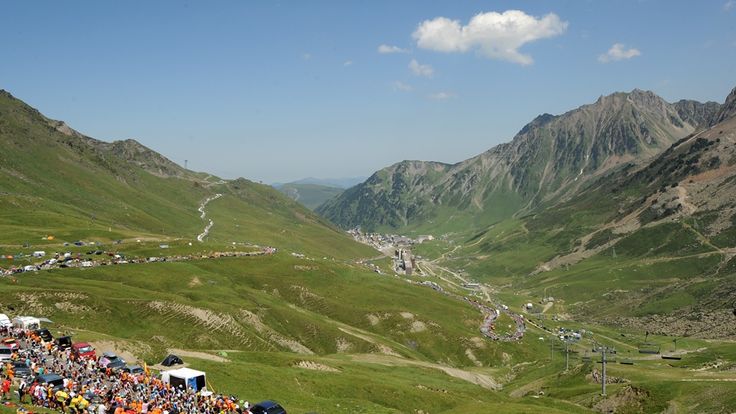The mountains are always an integral influence on the overall outcome of the Tour de France and with this year's race cresting some of England and France's toughest peaks, they are set to be as important as ever.
Chamrousse (stage 13)
Length: 18.2km
Average gradient: 7.3 per cent
Status: Hors categorie
The second-longest climb of this year's race and the longest of the summit finishes takes the riders more than 1,300 vertical metres up to the ski resort of Chamrousse on a winding road that starts out steep but eases off in the second half. One of several testing early ramps crests 16 per cent, but the challenge lies more in the consistency of the climb than the severity of the gradients. It rarely strays away from the seven and eight per cent mark, making for a long and demoralising slog that will weed out weaker legs and inevitably create splits between the general classification contenders.
Col d'Izoard (stage 14)
Length: 19km
Average gradient: 6.0 per cent
Status: Hors categorie
One of the Tour's most iconic climbs and the longest of this year's race, the colossal Izoard comes mid-stage and consequently won't have a decisive say on either the winner of stage 14, or the race overall. However, it remains a formidable obstacle - and could weaken legs ahead of the day's final climb to Risoul (see below). The devil in the Izoard is the fact that it gets gradually harder as the kilometres tick by, with a section that hovers consistently around the nine per cent mark at two-thirds distance proving particularly obstinate. A summit altitude of 2,360m could also prove challenging to any un-acclimatised riders.
Risoul (stage 14)
Length: 12.6km
Average gradient: 6.9 per cent
Status: Category one
For the second day in succession, a stage will end with a summit finish at a ski station, although the climb to Risoul is far less taxing than the preceding Chamrousse, weighing in at only two-thirds of the distance and averaging a slightly lower gradient. Nevertheless, it comes after the draining effort of the Izoard and offers plenty of scope for attacks and movement in the overall standings.
Port de Bales (stage 16)
Length: 11.7km
Average gradient: 7.7 per cent
Status: Hors categorie
The climb to Port de Bales is officially listed as 11.7km, but in reality, this deceptively long ascent starts far earlier and is closer to 20km, rising 1,155m from the town of Mauleo Barousse to the 1,755m summit. It doesn't start getting steep until the last 10km, though, when the gradient creeps up to nine per cent and later into double figures. The fact that the climb is followed by a descent of more than 20km to the finish line suggests it is unlikely to create significant splits between the general classification contenders, but it will create a stage-winning selection and remains one of the biggest obstacles of the whole race.
Saint-Lary Pla d'Adet (stage 17)
Length: 10.2km
Average gradient: 8.3 per cent
Status: Hors categorie
The climb to stage 17's summit finish at Pla d'Adet has the potential to be one of the most explosive of the race. It comes at the end of a shortest day of the Tour (just 124.5km) and so it is likely to be an attacking stage. What's more, the climb is at its toughest right at the bottom, with the first 4km averaging between nine and ten per cent in gradient. These early ramps are an ideal place to launch attacks and a select group could well go clear here. The climb actually flattens out at the top, so there could be a sprint if there is more than one rider still at the head of the race.
Col du Tourmalet (stage 18)
Length: 17.1km
Average gradient: 7.3 per cent
Status: Hors categorie
One of the most famous and revered climbs in cycling, the legendary Tourmalet makes a return to the Tour after a year's absence. The race organisers have once again positioned it mid-stage (in its 82 previous Tour appearances, it has only been used as a summit finish twice), but given that it is quickly followed by a summit finish on Hautacam, the Tourmalet has a vital role to play. It is so long that it could well thin the peloton right down, while it is so consistently steep that it could put any general classification contender who is beginning to tire under serious pressure. The second half of the climb is the hardest, while the descent off the other side could also provide a platform for attacks.
Hautacam (stage 18)
Length: 13.6km
Average gradient: 7.8 per cent
Status: Hors categorie
Hautacam is frequently overlooked by the Tour's race organisers (it has been used only once in the previous 13 years), but is a beauty of a climb and will provide a dramatic final mountain test of the 2014 race. Rising up out of the town of Argeles-Gazost and ascending towards the ski station at the top of the valley side, its gradient hovers between six and eight per cent for the first third of the climb, but then hits double figures for much of the second third, including one ramp in the high teens. This is possibly where riders with eyes on the stage win will make their attacks, before attempting to consolidate any advantage they might have on the slightly easier, twisting final slopes.
Find more of @VeloViewer's 3D profiles at veloviewer.com
